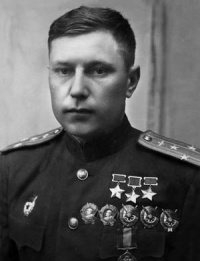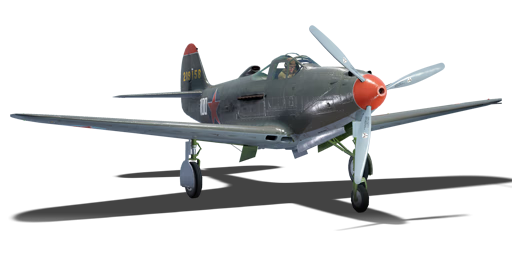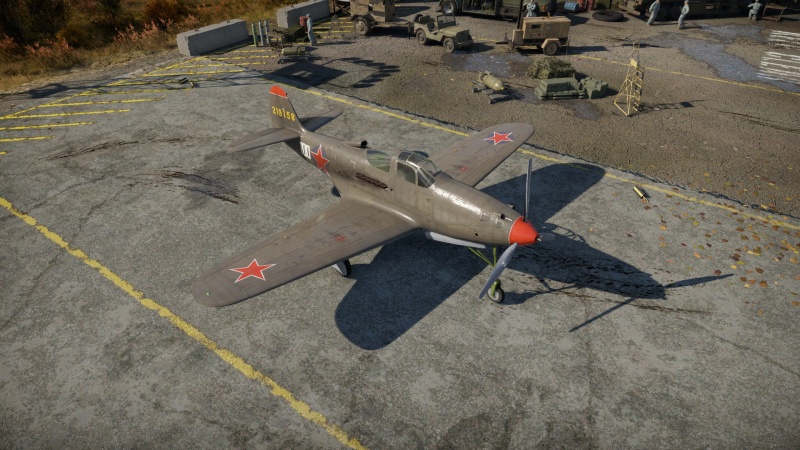Pokryshkin's P-39N-0 (USSR)
| This page is about the gift Soviet fighter Pokryshkin's P-39N-0 (USSR). For the American version, see P-39N-0. For other versions, see P-39 (Family). |
Contents
Description
▂Pokryshkin's P-39N-0 Airacobra is a premium gift rank III Soviet fighter
with a battle rating of 3.3 (AB) and 3.0 (RB/SB). It was introduced in Update 1.31 and has been made available yearly for Aleksandr Pokryshkin's birthday in the store and in-game for Golden Eagles ![]() since 2013.
since 2013.
The plane is painted after the camouflage scheme of Soviet ace pilot Alexander Pokryshkin in the 16th Guards Fighter Regiment, who scored most of his aerial victories in a lend-lease P-39. It differs from the regular P-39N-0 by the removal of all 4 wing-mounted .30 cal machine guns. This increases the overall performance of the plane, with almost no shortcomings.
This air-superiority fighter is able to dodge several enemies at once, prominently with the tactical use of turn fighting. The firepower, although reduced, is powerful and accurate thanks to the nose-mounted 37 mm M4 cannon. The 12.7 mm M2 Browning machine guns are fit for pilots seeking to engage numerous aircraft, particularly combined with the characteristic trigger discipline required by many Soviet planes.
Overall, the plane will prove to be reliable during mid-low altitude manoeuvres and lethal under the control of an ace pilot - a unique variant deserving collecting!
General info
Flight performance
This Soviet P-39N-0 is a low altitude fighter. Its Allison V-1710-85 engine can produce up to 1200 HP, however, it has only a single-stage, single-speed supercharger. Because of that, the plane performs optimally at low altitude (<4,000 m): at sea level, it can reach up to 575 km/h, with a maximum level speed of 644 km/h at 3,048 m. Thanks to that, it can outperform many other fighters like the early versions of Bf 109 or other American planes at that altitude range. The climb performance is decent, getting to 4,500 m should take about 4 minutes when flying with WEP enabled and full fuel tanks; below 1,000 m it can reach ~23 m/s. That puts it almost on par with some Bf 109 versions or the Yak-9, but only up to a certain altitude. Due to the engine limits, after flying for 5 minutes with WEP enabled it might start to overheat, especially with closed radiators. Reducing the propeller pitch to 90-95% and opening its radiators to 15-20% or more will significantly increase the length of time it can fly at full power.
Manoeuvrability-wise the Cobra is a decent plane. It can perform a full horizontal circle at 1,000 m in 18 seconds, but once it climbs above the altitude where its engine performs the best, the sustained turn rate will be getting worse due to insufficient power. However, even at low altitudes, it will not be able to outturn any Bf 109 E or F version, the P-40F or Yak-9 are also much better at dogfighting. The plane also locks up quite a lot above 600 km/h IAS, although it is very good at diving, its structural speed is 0 km/h, which is excellent compared to the other fighters at similar battle rating. Its roll rate is slightly improved compared to the American N-0 version because of the removal of the wing-mounted machine guns, at 400 km/h IAS it can reach ~90°/s, and 75°/s at 600 km/h IAS. The turn rate performance can be improved by using flaps, depending on the situation up to even ~20% at the cost of much higher drag. They can be extended to combat, take-off, or landing position, but their speed limit is quite low, up to 425 km/h IAS, losing them during the fight will significantly decrease the plane's dogfighting capabilities.
Simulator performance
In Simulator battles, the P-39 is a very stable plane. Unlike many other propeller-driven planes it does not require so much trimming to keep it steady, but remember the engine torque will be pushing the plane to the left; this will be more noticeable during WEP, so for cruising reduce the throttle to 90% for optimal flight performance, handling and fuel consumption.
The stalling characteristics can be violent and almost unrecoverable, it will reaching maximum AoA (Angle of Attack) at ~55% elevator deflection, or at 70% with combat flaps. After exceeding the maximum AoA, the plane will stall and then spin within a few seconds. Recovering from that state will take another few seconds or become almost impossible depending on the fuel loadout (the more fuel, the harder to recover) and it is possible to lose even 1,500 m of altitude during that.
| For better control, proceed to a test flight, trim the aircraft while cruising and save the trimming configuration. |
| Characteristics | Max Speed (km/h at 3,048 m) |
Max altitude (metres) |
Turn time (seconds) |
Rate of climb (metres/second) |
Take-off run (metres) | |||
|---|---|---|---|---|---|---|---|---|
| AB | RB | AB | RB | AB | RB | |||
| Stock | 616 | 595 | 9700 | 18.9 | 19.9 | 11.0 | 11.0 | 280 |
| Upgraded | 683 | 644 | 17.8 | 18.0 | 21.7 | 15.4 | ||
Details
| Features | ||||
|---|---|---|---|---|
| Combat flaps | Take-off flaps | Landing flaps | Air brakes | Arrestor gear |
| ✓ | ✓ | ✓ | X | X |
| Limits | ||||||
|---|---|---|---|---|---|---|
| Wings (km/h) | Gear (km/h) | Flaps (km/h) | Max Static G | |||
| Combat | Take-off | Landing | + | - | ||
| 886 | 322 | 426 | 396 | 241 | ~13 | ~9 |
| Optimal velocities (km/h) | |||
|---|---|---|---|
| Ailerons | Rudder | Elevators | Radiator |
| < 360 | < 380 | < 450 | > 312 |
Survivability and armour
- Armour plates
- 15.87 mm (5°) Steel - Propeller hub
- 15.87 mm (15°) - Plate in front of the cockpit
- 7 mm (67°) Steel - Plate over instrument cluster
- 6 mm (5-16°) Steel - Upper pilot's seat and headrest encasement
- 6 mm (5°) Steel - Rear tail
- 38 mm (71°) Bulletproof glass - Windscreen
- 64 mm (5°) Bulletproof glass - Headrest of pilot's seat
- Critical components
- The engine is located behind the pilot
- Cooling systems are under the engine and in the middle of the the tail section.
- Self-sealing fuel tanks are located at the root of each wing.
Modifications and economy
Armaments
Offensive armament
Pokryshkin's P-39N-0 (USSR) is armed with:
- 1 x 37 mm M4 cannon, nose-mounted (30 rpg)
- 2 x 12.7 mm M2 Browning machine guns, nose-mounted (200 rpg = 400 total)
Usage in battles
The Russian P-39N works basically like the American version, the only difference being lower mass due to removed machine guns and slightly improved roll and turn rate as a result. In Realistic battles it can take advantage of excellent low altitude performance, most low tier battles in which it will participate will take place there. Climbing in this plane is not an issue, it can get to 5,000 m in slightly over 4 minutes, so after reaching it will most likely encounter other fighters like the Bf 109 E/F, or the American counterparts at similar altitude.
Committing to extended dogfighting against any planes is not recommended, at its battle rating it can be out-turned by several more nimble planes such as the Japanese Zero, the British Spitfires and the Italian Re.2001 CN. In these scenarios it is best to keep up its speed, which in some cases is even 100 km/h higher compared to other fighters, then try to Boom and Zoom or perform chandelle manoeuvres with smart MEC usage.
The 37 mm cannon has low rate of fire and somewhat low muzzle velocity, so it is best to surprise-attack slower targets such as heavy fighters, attackers, and bombers. Going head-on with most other heavily armed planes like the Bf 109 or Fw 190 A-1 will end up badly; the armament is too unreliable for that. Head-ons should be performed skillfully as last resort versus enemies with a nimble and weaker airframe such as the previously mentioned dogfighters.
Enemies worth nothing
Against German aircraft it might struggle a little bit, the Bf 109 has better climb and is also better at instant turning so in most situations it is just best to start using the superior level speed from 0 to 4,000 m, or go for a very shallow dive, they will not be able to keep up because of lower structural speed. The only concern can be the Fw 190 A-1, its level speed is almost as high and gets higher above 5,000 m, the best way to win against them is just by using the superior turn rate, but the player should still be careful, the Fw 190 has a great roll rate, it might try to make the other planes overshoot.
Against Britain, the only planes that pose a major challenge are the Spitfire variants. Their turn rate is far superior, the climb rate is also very similar, although they are worse in firepower and durability, and will also suffer from overheating issues in any prolonged fight (especially on desert maps), so they will start bleeding their speed very fast or otherwise damage their engine. In most cases, it is best to go for Boom and Zoom or high-speed Hit and Run tactics.
Against Italy, the only planes that can cause any problems are the C.202 and C.205 series. The C.202 is a much slower plane, its climb rate is also worse and the turn rate of the version with cannons very similar, it can be dealt with by either Boom and Zooming it or just dogfighting, but it is not recommended unless there are no other planes around, as it will make the plane slow and easy to shoot down, using the speed advantage is much less risky. The C.205 is a harder enemy to deal with, its level speed is still slower, by ~30-40 km/h (depending on the version), but the climb rate performance is the same, it also gets faster above ~4,500 m. Both the Cobra and Macchi have also very similar turn rate, dogfighting in this situation will mostly depend on the player's skill, but the C.205 has a much easier time with snapshots and high angle attacks. In addition, the cannon version is equipped with three 20 mm cannons, going head-to-head will almost certainly end badly, so after the encounter at similar altitude the P-39 will most likely be pushed to a defensive position, although it can still run away, the structural speed limit is higher by 80 km/h and the lower it gets in altitude, the higher chance the Cobra has for winning.
Simulator battles
In Simulator battles, its capabilities are limited by subpar visibility from its cockpit and the position of its gun sight, which is very low. This makes high angle attacks and leading the target harder.
Manual Engine Control
| MEC elements | ||||||
|---|---|---|---|---|---|---|
| Mixer | Pitch | Radiator | Supercharger | Turbocharger | ||
| Oil | Water | Type | ||||
| Controllable | Controllable Not auto controlled |
Controllable Not auto controlled |
Controllable Not auto controlled |
Separate | Not controllable 1 gear |
Not controllable |
Pros and cons
Pros:
- Great acceleration and great top speed in dive
- Good climb rate at low altitude
- Great top speed up to 4,000 m
- Decent roll rate
- Decent vertical and horizontal manoeuvrability
- 37 mm cannon does a lot of damage when hitting enemy aircraft
Cons:
- Rudder stiffens at high speed
- Mediocre armament, low cannon's rate of fire and only two machine guns
- 37 mm cannon has slow velocity which makes it hard to lead
- Poor high altitude performance
History
| Archive of the in-game description | |
|---|---|
|
Bell's P-39 Airacobra was a WWII-era American fighter that was notable for its uncommon design: the engine was placed behind the cockpit, and the landing gear moved from the tail to the nose. The aircraft was adopted by five countries: USA, Britain, Soviet Union, Portugal and Australia. The P-39N was the first variant to be mass produced, with the P-39N-0 getting a new V-1710-85(E19) engine and a 3-blade Aeroproducts propeller with a 3.15 meter diameter. Starting from aircraft #167, some fuel tanks were removed from the wings to reduce weight, and a connection for additional fuel tanks was installed under the hull. To further increase flight performance, Soviet engineers often removed the wing-mounted machine guns, leaving two nose machine guns and a cannon. As this variant, Bell produced 2,095 aircraft. Most of these were sent to the Soviet Union on the US's Lend-Lease program. In November 1942, the USSR received the first Airacobras, and the fighters showed good results in battle manoeuvres at low and moderate altitudes. Many famous Soviet aces — such as Pokrishkin Alexander Ivanovich, Rechkalov Gregory Andreevich, Gulaev Dmitry Nikolaevich and Kutakhov Pavel Stepanovich — piloted the Airacobras during WWII. | |
Notable pilots

Media
- Skins
- Videos
See also
- Aircraft of comparable role, configuration and era
- Other US-supplied Soviet fighters
External links
- 2013 - Ace of the Month: Alexander Pokryshkin
- 2014 - Aleksandr Pokryshkin - the air tactician
- 2015 - [Special] Pokryshkin's P-39
- 2016 - [Special] V for Victory!
- 2017 - No news announcement but the sale took place
- 2018 - [News] Birthday of Alexander Pokryshkin
- 2019 - [News] Birthday of Alexander Pokryshkin
- 2020 - [News] Alexander Pokryshkin's birthday
- 2021 - P39N-0 for Alexander Pokryshkin's birthday
| Bell Aircraft Corporation | |
|---|---|
| Aircraft | |
| Fighters | P-39N-0 · P-39Q-5 |
| P-400 | |
| P-63A-10 · P-63A-5 · P-63C-5 · ␠Kingcobra | |
| Jet Fighters | P-59A |
| Export | ▂P-39K-1 · ▂Pokryshkin's P-39N-0 · ▂P-39Q-15 · ▄P-39Q-25 |
| ▂P-63A-5 · ▂P-63A-10 · ▂P-63C-5 · ▄P-63C-5 | |
| Helicopters | |
| Attack | AH-1F · AH-1G · AH-1Z · AH-1W |
| OH-58D | |
| Utility | UH-1B · UH-1C · UH-1C XM-30 |
| Export/Licensed | ▅UH-1B · ◄UH-1D |
| Tzefa A · Tzefa B · Tzefa D/E · ▅AH-1S early · ▅AH-1S · ▅AH-1S Kisarazu · ␗AH-1W | |
| ␗OH-58D | |
| See Also | Fuji Heavy Industries · Agusta |
| USSR fighters | |
|---|---|
| I-15 | I-15 WR · I-15 M-22 · I-15 M-25 · I-15bis · Krasnolutsky's I-15bis |
| I-153 M-62 · Zhukovsky's I-153-M62 · I-153P | |
| I-16 | I-16 type 5 · I-16 type 10 · I-16 type 18 · I-16 type 24 · I-16 type 27 · I-16 type 28 · I-180S |
| I-29 | I-29 |
| I-185 | I-185 (M-71) · I-185 (M-82) |
| I-225 | I-225 |
| ITP | ITP (M-1) |
| MiG-3 | MiG-3-15 · MiG-3-15 (BK) · MiG-3-34 |
| LaGG | I-301 · LaGG-3-4 · LaGG-3-8 · LaGG-3-11 · LaGG-3-23 · LaGG-3-34 · LaGG-3-35 · LaGG-3-66 |
| La | La-5 · La-5F · La-5FN · La-7 · Dolgushin's La-7 · La-7B-20 · La-9 · La-11 |
| Yak-1/7 | Yak-1 · Yak-1B · Yak-7B |
| Yak-3 | Yak-3 · Yak-3P · Yak-3T · Yak-3U · Yak-3 (VK-107) |
| Yak-9 | Yak-9 · Yak-9B · Golovachev's Yak-9M · Yak-9T · Yak-9K · Yak-9U · Yak-9UT · Yak-9P |
| Other countries | ▂P-40E-1 · ▂P-47D-27 · ▂Hurricane Mk IIB · ▂Fw 190 D-9 · ▂Spitfire Mk IXc |
| P-39 | ▂P-39K-1 · ▂Pokryshkin's P-39N-0 · ▂P-39Q-15 |
| P-63 | ▂P-63A-5 · ▂P-63A-10 · ▂P-63C-5 |
| USSR premium aircraft | |
|---|---|
| Fighters | Krasnolutsky's I-15bis · I-16 type 28 · Zhukovsky's I-153-M62 · I-153P · I-180S · I-301 · ITP (M-1) |
| LaGG-3-4 · LaGG-3-23 · LaGG-3-34 · Dolgushin's La-7 · La-11 | |
| Yak-3 (VK-107) · Yak-3T · Golovachev's Yak-9M | |
| ▂P-39K-1 · ▂Pokryshkin's P-39N-0 · ▂P-39Q-15 · ▂P-40E-1 · ▂P-47D-27 · ▂P-63A-5 · ▂P-63A-10 · ▂P-63C-5 | |
| ▂Hurricane Mk IIB · ▂Spitfire Mk IXc · ▂Fw 190 D-9 | |
| Twin-engine fighters | I-29 |
| Jet fighters | Su-11 · MiG-15bis ISH · MiG-17AS · MiG-21S (R-13-300) · MiG-23ML |
| Strike aircraft | IL-2M "Avenger" · IL-2 M-82 · IL-8 (1944) · Su-6 · Tandem MAI · TIS MA · Su-8 · Tu-1 |
| Yak-38 · Su-7BMK · Su-25K · Su-39 | |
| Bombers | Po-2M · Be-6 · MBR-2-M-34 · Pe-2-205 · TB-3M-17-32 |
| ▂PBY-5A Catalina · ▂Hampden TB Mk I · ▂A-20G-30 · ▂B-25J-30 | |





